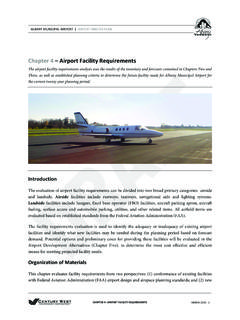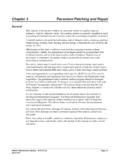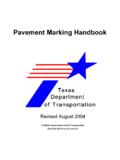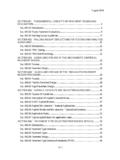Transcription of Porous Pavement alternatives Cost analysis 1. INTRODUCTION
1 Metro Porous Pavement alternatives cost analysispage 1century west engineeringPorous Pavement alternatives cost analysisprepared by century west engineering for metrothis cost analysis compares the construction costs of six different types of Pavement for three different scenarios. the purpose of the analysis is to give builders a way to compare the relative costs of Porous pavements. the cost estimates are based on a number of assumptions and on one engineering firm s designs. Porous and conventional Pavement costs vary depending on site conditions, market conditions, engineering designs, local permit require-ments and other factors. in addition, this memo presents costs for construction only and does not take into account lifetime cost of each Pavement . metro encourages the use of Porous surface options when appropriate and in jurisdictions that permit it, but metro does not promote any particular Pavement INTRODUCTIONDue to current requirements for management of stormwater runoff, a number of new technologies have emerged in recent years to manage both the quality and quantity of stormwater runoff associated with urban development.
2 One technology that has received increased attention is Porous Pavement . Porous Pavement allows disposal of run-off via direct infiltration from the developed surface. this ability to use paved surfaces to dispose of storm water offers a number of benefits including; efficient use of developable land by utilizing the paved footprint on a site for stormwater management; improved treatment compared with other stormwater Bmp s; and reducing runoff to rivers, lakes, and streams reducing erosion and storm surge and improving overall water quality. one of the barriers to wider use of Porous pavements is the perception that Porous Pavement is more costly than conventional Pavement and related stormwater management systems. in order to provide a better understand-ing of the true costs of Porous Pavement compared to other paving systems, the metro sustainability center has undertaken a study to estimate the relative costs for a number of Pavement systems both Porous and non- Porous .
3 The objective is to provide comparisons that will be helpful to land developers and municipalities in the planning and design of site improvements. century west engineering has been commissioned to perform the analysis and summarize their findings and results. this memo presents the findings and conclusions of this DESIGN SCENARIOS three scenarios were considered. included were: Neighborhood Roadway a roadway roughly consistent with a 200 city block. assuming 50 lots, the street would access eight homes. the width would be sufficient to accommodate two 12 travel lanes with 10 for parking on one side of the street. Based on these requirements the street s paved area would total 6,800 sF. it is assumed that the street will be curbed; however, sidewalks were not considered for this Porous Pavement alternatives cost analysispage 2century west engineering Parking Lot a parking lot for a small business. the lot would include ten 10 x20 stalls and a 50 x24 drive aisle.
4 The total area would be 3,200 sF. curbs, but no sidewalks, are assumed. Driveway a driveway large enough for three cars with room for some maneuvering. 800 sF of Pavement is DESIGN ALTERNATIVESsix Pavement sections were considered for the three scenarios listed above. these included: Porous asphalt Pavement pervious concrete Pavement permeable interlocking concrete pavers Porous gravel with a geo-cellular grid conventional asphalt plus Drainage structures conventional concrete plus Drainage structureseach section was designed based on uniform assumptions of traffic loading for a 20-year life to produce Pavement sections that will perform comparably. the Pavement sections presented are based on conservative assumptions resulting in thicker sections than might be typically used. actual sections for a particular application will depend on site specific soil conditions and traffic Pavement Structural Section traffic loading for each scenario was determined based on equivalent axle loadings (eals) anticipated over a 20 year period and average Daily truck traffic (aDtt).
5 Both construction and operational traffic were considered. Based on these assumptions the following traffic loads were projected. neighborhood roadway 25,000 eals, aDtt= parking lot 14,000 eals, aDtt= Driveway minimal trafficsoils were assumed to have fair suitability for subgrade construction. a california Bearing ratio (cBr) of 5 was used for Pavement section surface course strength for Porous asphalt was considered roughly equal in strength to its non- Porous coun-terpart. However, for concrete the compressive strength of pervious concrete is roughly 2,500 psi, considerably less than the 4,350 psi assumed for non- Porous . to offset this difference, thicker slabs are specified for pervious concrete. in this study, concrete slab thicknesses were increased by 50% to offset the lower strength of pervious , for Porous asphalt and pervious concrete surfaces, the aggregate section has consisted of coarse aggregate that serves as the structural section and as a recharge bed for the storage and disposal of storm runoff.
6 This layer was frequently overlaid with a choker course consisting of more finely graded rock. the choker course fills in the larger void space at the surface of the coarse aggregate layer and provides a more stable working surface for construction. in recent years, a use of a finely graded choker course over a coarse aggregate recharge bed, has been replaced with the use of a finer overall section. this is the approach taken for this aggregate is used. although a wide range of aggregate grades have been and are used for base courses, 1 -1/4 was assumed for this study. this aggregate has similar structural properties to the aggregate used for non- Porous pavements. the resulting sections are comparable to their non- Porous counterparts. the main difference is that Porous sections may be thicker due to the need for storage of runoff. this is discussed fur-ther in the following Porous Pavement alternatives cost analysispage 3century west engineeringFor permeable interlocking concrete pavers and geo-cellular reinforced sections, aggregates such as oDot -#4 or 1 -#4 are used.
7 These maintain the void ratios necessary for storage while retaining structural properties needed for resistance to rutting from turning, braking, and acceleration conventional paved surfaces, standard dense graded aggregates were of the published design guidelines utilize aasHto specifications for aggregate base rock. to better relate Porous Pavement designs to local standards, we have attempted to use commonly available gradations. oDot specifications for base rock were utilized where Stormwater Storage For the Porous Pavement alternatives , storage of stormwater is considered in the design. a typical Porous Pavement section must be capable of storing the precipitation total for the design storm event and allowing that total to infiltrate within 24 hours following that event. the design storm event used in the portland area is a 10-yr/24-hr event. according the city of portland s stormwater management manual, the precipitation total for this event is equal to inches.
8 Given that the aggregate used in most Porous Pavement sections has a void ratio of approximately 40%, a minimum thickness required for stormwater storage in Porous Pavement sections is determined from the following Aggregate = inches = inches is the minimum thickness used for storage of storm runoff in this study. Depending on structural requirements for a specific Pavement section, and the void ratio of aggregate used for a specific application, this thickness may Based on the above traffic loads and soil characteristics, the following Pavement sections were designed. although each system has its own unique regimen for maintenance , the sections listed are roughly equivalent and, with proper care and maintenance , provide adequate levels of service over a 20-year cost ANALYSISpa ving costs for each of the three scenarios was estimated. unit costs for construction were estimated based on recent bids for similar work by local contractors.
9 A summary of the costs is given surface Base materialinches inchessizecostpervious concrete 69 2 -1 $7,5702 1 -#4porous asphalt39 2 -1 $4,3302 1 -#4permeable paverspaver 9 1 -#4 $11,760plastic grid reinforced gravelgeocell 9 -#4 $3,930conventional concrete 44 1 -0 $5,330conventional asphalt 36 1 -0 $3,520 metro Porous Pavement alternatives cost analysispage 4century west engineeringpa rking lot surface Base materialinches inchessizecostpervious concrete 8 9 2 -1 $44,9302 1 -#4porous asphalt39 2 -1 $25,9602 1 -#4permeable paverspaver 12 1 -#4 $57,150plastic grid reinforced gravelgeocell 9 -#4 $24,680conventional concrete 5 6 1 -0 $32,200conventional asphalt 38 1 -0 $23,680 ne igH BorHooD roaD surface Base materialinches inchessizecostpervious concrete 89 2 -1 $95,3602 1 -#4porous asphalt49 2 -1 $58,9202 1 -#4permeable paverspaver 12 1 -#4 $110,260plastic grid reinforced graveln/a n/a n/a n/a conventional concrete 56 1 -0 $72,320conventional asphalt 48 1 -0 $57,540 the costs assumed key items related to the construction of each improvement.
10 maintenance costs were not included. For the non- Porous alternatives , costs for drainage facilities were included for the neighborhood road and the parking lot. For the neighborhood road this included four inlets, two manholes, and 300 lF of 12 storm sewer. For the parking lot this included a single inlet and 50 lF of 12 storm sewer. no drainage was assumed for the drainage facilities were included for the Porous Pavement alternatives to capture excess stormwater that may not infiltrate. overflow drainage facilities may not be necessary for sites with highly permeable soils. this would lower overall costs for these alternatives . overflow drainage facilities for the neighborhood road section in-cluded two inlets, one manhole, and 35 lF of 12 storm sewer. For the parking lot, a single inlet and 65 lF of storm sewer were assumed. as with the non- Porous driveway, no drainage facilities were water quality facilities such as ponds or swales were Porous Pavement alternatives cost analysispage 5century west engineering5.





